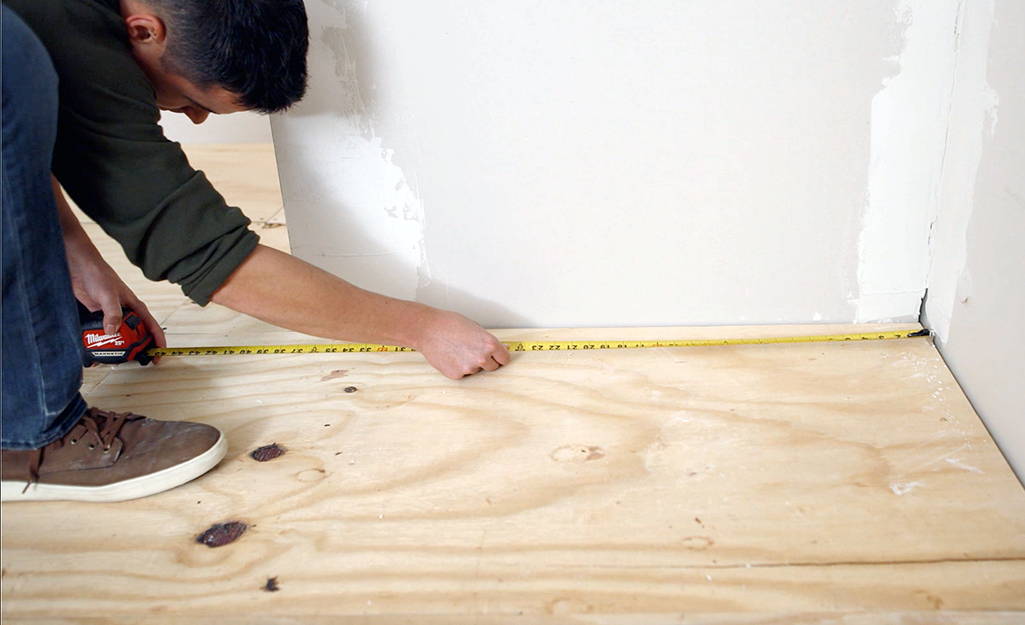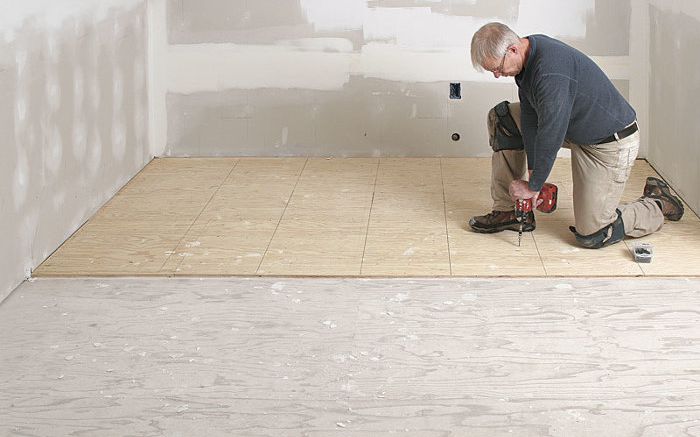Looking to tile your floor? Wondering what type of plywood to use as a base? Look no further! In this article, I’ll answer the burning question: “What plywood under tiles?”
Plywood is a versatile material often used as a subfloor for tile installation. But before you rush to the hardware store, let’s delve into the details. The type of plywood you need depends on various factors, such as the subfloor condition, tile type, and room moisture levels.
Now, you might be wondering, “Why is plywood necessary at all?” Well, plywood provides a stable and smooth surface for your tiles, preventing them from cracking or shifting over time. So, let’s explore the different types of plywood and discover which one is best suited for your tiling project.
So, are you ready to find out which plywood will work wonders under your tiles? Let’s get started!

What Plywood to Use Under Tiles?
Understanding the Importance of Plywood Under Tiles
When it comes to tile installation, one crucial factor that often gets overlooked is the type of plywood to use as an underlayment. Plywood underlayment serves as a stable and smooth surface for the tiles, preventing them from cracking or shifting over time. Choosing the right plywood can make a significant difference in the longevity and performance of your tiled floor. In this article, we will discuss the different types of plywood suitable for tile installation and provide essential tips for a successful project.
The Role of Plywood Under Tiles
The plywood underlayment acts as a substrate for the tiles, providing a stable and even base. It helps distribute the weight of the tiles and absorbs any minor movement in the subfloor, preventing cracks and potential damage. It also provides a smooth surface for the tiles to adhere to, ensuring proper adhesion and reducing the risk of tiles popping off. Additionally, plywood underlayment helps minimize moisture issues, as it acts as a barrier between the tiles and any moisture from the subfloor.
The Types of Plywood Suitable for Tile Installation
1. Exterior-grade Plywood: This type of plywood is suitable for areas with higher moisture levels, such as bathrooms and kitchens. It is made with water-resistant glue and can withstand exposure to moisture without warping or delaminating. Exterior-grade plywood should have a minimum thickness of 5/8 inch for tile installations.
2. Underlayment-grade Plywood: Underlayment-grade plywood is specifically designed for use as a subfloor or underlayment. It has a smooth surface and is made with interior-grade glue. It is recommended for areas with moderate moisture levels, such as living rooms and bedrooms. The thickness of underlayment-grade plywood should be at least 1/2 inch for tile installations.
3. Cement Backer Board: While not technically plywood, cement backer board is an alternative underlayment material commonly used for tile installations. It is made of cement and reinforced with fiberglass mesh for added strength and stability. Cement backer board is suitable for high-moisture areas and is resistant to mold and mildew. It is available in varying thicknesses, with 1/4 inch and 1/2 inch being the most common choices for tile installations.
Benefits of Using Plywood Under Tiles
There are several benefits to using plywood as an underlayment for tiled floors:
1. Stability: Plywood provides a stable and rigid surface for the tiles, preventing them from shifting or cracking.
2. Moisture Resistance: Properly installed plywood underlayment helps minimize moisture-related issues, such as warping or mold growth.
3. Easy Installation: Plywood is relatively easy to install, making it suitable for both DIY enthusiasts and professional contractors.
4. Cost-effective: Plywood is an affordable option compared to other underlayment materials, making it accessible for various budget ranges.
5. Versatility: Plywood can be used with a wide range of tile materials, including ceramic, porcelain, and natural stone.
6. Improves Sound Insulation: Plywood underlayment can help reduce sound transmission between floors, improving overall acoustic performance.
Tips for Choosing and Installing Plywood Underlayment
Here are some essential tips to keep in mind when selecting and installing plywood underlayment for tile projects:
1. Choose the Correct Thickness: Ensure the plywood is thick enough to provide adequate support for the tiles. Consult the tile manufacturer or a professional installer for the recommended thickness based on your specific project.
2. Use the Correct Type of Plywood: Select a plywood grade that is appropriate for the moisture levels in your space. Exterior-grade plywood is suitable for high-moisture areas, while underlayment-grade plywood works well in moderate moisture environments.
3. Prepare the Subfloor: Before installing the plywood underlayment, ensure that the subfloor is clean, dry, and free from any debris. Repair any damaged areas or uneven surfaces to create a smooth and even base.
4. Use Proper Fasteners: Use corrosion-resistant screws or nails to secure the plywood to the subfloor. Ensure that the fasteners penetrate both the plywood and the subfloor, providing a secure attachment.
5. Leave Expansion Gaps: Leave small gaps around the perimeter of the plywood to allow for natural expansion and contraction. Consult the manufacturer’s guidelines for the recommended gap size.
6. Follow Industry Standards: Adhere to industry standards and guidelines for tile installation to ensure a successful and long-lasting project. Seek professional advice if needed.
In conclusion, choosing the right plywood underlayment is crucial for a successful tile installation. By considering factors such as moisture resistance, stability, and ease of installation, you can ensure a durable and beautiful tiled floor. Follow the recommended guidelines and consult professionals when needed to achieve the best results. With proper preparation and installation, your tiled floor will stand the test of time.
Key Takeaways – What Plywood Under Tiles?
- Using plywood under tiles provides a stable and flat surface for installation.
- Plywood should be water-resistant or marine grade to prevent warping or damage.
- Ensure the plywood is securely fastened to the subfloor to prevent movement.
- Applying a waterproofing membrane over the plywood can further protect against moisture.
- Follow industry guidelines and consult with professionals for proper installation techniques.
Frequently Asked Questions
Welcome to our frequently asked questions section about using plywood under tiles. Here, we will address some common queries you may have when considering the use of plywood as a subfloor for tile installation.
1. Why is plywood used under tiles?
Plywood is often used as an underlayment for tiles because it provides a stable and level surface. It helps to prevent cracks and movement in the tiles by evenly distributing the load. Plywood also helps to minimize the transfer of moisture from the subfloor to the tiles, reducing the risk of damage over time.
Furthermore, plywood can help to address unevenness in the subfloor, ensuring a smooth and flat surface for the tiles to be installed on. It offers durability and strength, making it a reliable choice for supporting and protecting your tile flooring.
2. What type of plywood should I use under tiles?
When choosing plywood for use under tiles, it’s important to select a suitable grade and thickness. The preferred option is typically exterior-grade plywood, which is moisture-resistant and less prone to warping or rotting when exposed to water.
As for thickness, 3/4-inch plywood is commonly recommended for tile installations. Thinner plywood may not provide adequate support, while thicker plywood can add unnecessary weight to the floor. However, it’s always best to consult with a professional or follow the recommendations provided by your tile manufacturer or installer for the specific requirements of your project.
3. Do I need to prepare the plywood before tiling?
Yes, it is essential to properly prepare the plywood before tiling. Start by ensuring that the plywood is clean, dry, and free of debris. Remove any protrusions or loose sections, and patch any holes or gaps with a suitable wood filler or patching compound.
Next, it’s recommended to apply a primer or sealer to the plywood surface. This helps to improve the adhesion of the tile adhesive, ensuring a strong bond between the tiles and the underlayment. Follow the instructions provided by the primer or sealer manufacturer for the best results.
4. Can plywood under tiles prevent tile cracking?
While plywood under tiles can help minimize the risk of tile cracking, it is not a foolproof solution. Proper installation techniques, such as using an appropriate adhesive and following the correct grout joint spacing, are equally important in preventing cracks. Additionally, ensuring that the subfloor is level and free from movement will further reduce the likelihood of tile cracking.
If you have concerns about tile cracking, it’s advisable to consult with a professional tile installer or seek guidance from your tile manufacturer for specific recommendations based on your project’s requirements.
5. Can I install tiles directly on top of plywood?
While it is possible to install tiles directly on plywood, it is not the recommended method. Plywood alone may not provide sufficient support and stability for the tiles, especially if the subfloor is prone to movement or moisture. Over time, this can lead to tile damage and failure.
It is generally recommended to use an appropriate underlayment, such as cement backer board, over the plywood before installing tiles. Cement backer board offers enhanced strength and moisture resistance, ensuring a more reliable and long-lasting tile installation.
Summary
Plywood is a type of wood that you can put under tiles to make them sturdy. It helps prevent cracking and keeps the tiles in place. Make sure to choose plywood that is of good quality and has the right thickness for your tiles. Remember to also prepare the plywood properly by cleaning and sealing it.
When installing plywood under tiles, it’s important to follow the right steps. Start by measuring and cutting the plywood to fit your floor. Then, secure it properly using screws or adhesive. After that, you can lay your tiles on top of the plywood, making sure they are evenly spaced. Following these steps will help you create a strong and durable tiled floor.

